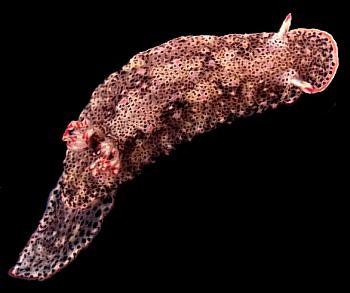
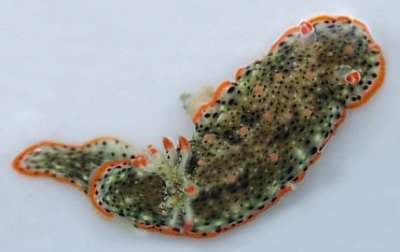
Glossodoris dalli
(Bergh, 1879)
Order: NUDIBRANCHIA
Suborder: DORIDINA
Superfamily: EUDORIDOIDEA
Family: Chromodorididae
DISTRIBUTION
Tropical East Pacific - Baha California to Galapagos Ids.
PHOTO
UPPER: Shallow subtidal off Isla Luz, Bahia de Concepcion, Sea of Cortez, Mexico. February, 1992. Photo: Jeff Goddard.
LOWER: Careyeros, intertidal. Bahia de Banderas, Mexico. 23 February, 2002. Photo: Alicia Hermosillo
Translucent white background colour with black/brown spots on the mantle and the sides of the body. Cream, and sometimes orange to red spots are mixed among the blackish mantle. Rhinophores and gills are white with orange or light red tips.
Reference:
• Bertsch, H. (1978). The Chromodoridinae Nudibranchs from the Pacific Coast of America – Part III. The genus Chromolaichma and Mexichromis. The Veliger, 21(1): 70-86.
Synonyms are C. banksi and C. sonora. See Jeff Goddard's message for further photos.
Authorship detailsRudman, W.B., 2000 (October 10) Glossodoris dalli (Bergh, 1879). [In] Sea Slug Forum. Australian Museum, Sydney. Available from http://www.seaslugforum.net/find/glosdall
Related messages
Glossodoris dalli from the Galapagos Ids
December 28, 2004
From: Julianne Parolisi
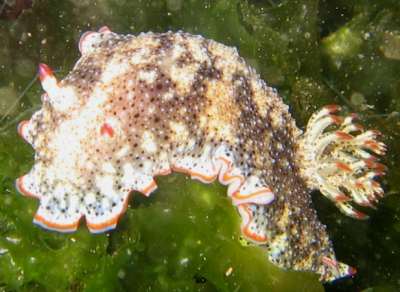
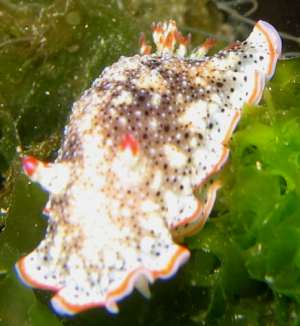
Dear Bill,
first off, thank you so much for maintaining this website, it's absolutely brilliant! i have long been fascinated by (and recently quite obsessed with) nudibranchs and other sea slugs, so upon discovery of your site today i have been literally sucked to my computer for HOURS browsing photos, reading, and generally soaking up information- i love it! :)
now on to the questions... for the past few months i have been living and diving in the Galapagos Islands, and i am very curious about a few nudis i spotted there, but have been unable to find precise answers on your site.
the first is the one pictured here,, after searching your database, it seems that the most likely candidate would be Glossodoris dalli, it's just about identical except mine is more brown/black spotted than greenish like the ones pictured here. could you please confirm (or deny) that for me?
Locality: Isabela Island, Galapagos Ids, Ecuador, East Pacific Ocean
Depth: ~ 3 meters. Length: ~ 1 inch
3 December 2004, Mangroves
Photographer: Julianne Parolisi
My second is a little tougher as i unfortunately don't have a photo, but this was the sweetest little thing i've ever seen and i'm dying to know what it is.... i was doing a dive around santa cruz island and at about 8 meters i spotted a tiny (~ 1 cm) bright yellow plump round slug with a circle of purplish dots on its back. it was very smooth with 2 tiny rhinophores but no gills to speak of, and i seem to remember it having a bit of a tail-like point at the back. the closest thing i could find on your site was Berthellina citrina, but none of those pictures had anything resembling the purple circle on the back that mine had. any ideas?
thank you so much,
Julianne
aurorable@gmail.com
Parolisi, J., 2004 (Dec 28) Glossodoris dalli from the Galapagos Ids. [Message in] Sea Slug Forum. Australian Museum, Sydney. Available from http://www.seaslugforum.net/find/12832Dear Julianne,
Glad you like the Forum. I would certainly be interested in photos of any sea slugs you find there. As you no doubt have seen already on the Forum, we are interested in any species, no matter how common, and particularly if the photos can give us any information, or cluse, about the species biology or natural history.
Your photos are of Glossodoris dalli. I guess it's possible that there is more than one very similarly coloured species but you would need to compare the anatomy of different coloured animals and see if you can find any behavioural differences, such as food choice, before we could say anything sensible. I'm afraid your yellow one with the purple ring is a mystery to me. Perhaps someone with a personal knowledge of the east Pacific fauna could help us out.
Best wishes,
Bill Rudman
Glossodoris dalli from Mexico
March 23, 2002
From: Alicia Hermosillo
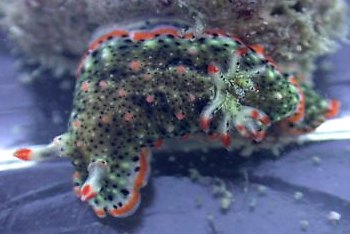

Here are photos of Glossodoris dalli I found on the 23 February, 2002 at Careyeros, Bahia de Banderas, Pacific coast of Mexico.
We got there 90 minutes before the lowest tide of the day carrying out intertidal observations in the tide pools and rocks. There were 4 of us. After 75 minutes of observation we reported 71 specimens of 3 different species: 69 Elysia diomedea, 1 Glossodoris dalli and 1 Hypselodoris agassizii.
Locality data: Careyeros, Bahia de Banderas, State of Jalisco and Nayarit, Mexico.
Alicia Hermosillo.
gueri25@hotmail.com
Hermosillo, A., 2002 (Mar 23) Glossodoris dalli from Mexico. [Message in] Sea Slug Forum. Australian Museum, Sydney. Available from http://www.seaslugforum.net/find/6492Thanks Alicia,
Bill Rudman
Three eastern Pacific chromodorids
October 13, 2000
From: Jeff Goddard

Hi Bill,
Here are photographs of three species of chromodorids not yet pictured in the Forum. I found the Glossodoris sedna and G. dalli in the shallow subtidal off Isla Luz, Bahia de Concepcion in the Sea of Cortez, and the Chromodoris norrisi in shallow water off Izla Danzante, also in the Sea of Cortez. All were found in February, 1992.
I have not studied any aspect of the biology of these species, but could not help but notice how actively G. sedna wiggled its gill plumes. This was striking to someone used to observing temperate water dorids. I assume this activity facilitates gas exchange in warmer waters. Is it common in shallow water, tropical chromodorids?
Best wishes,
Jeff
goddard@lifesci.ucsb.edu
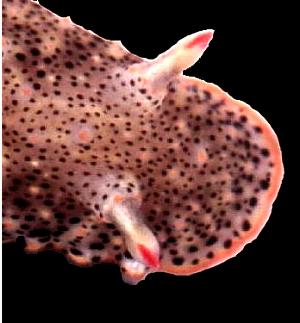

Dear Jeff,
Thanks for the photos. I have moved the photos of Glossodoris sedna and Chromodoris norrisi to separate pages. Your question about wriggling gills is interesting. Many species of Glossodoris wriggle their gills as you have observed for G. sedna. I thought at first that it could be linked to physiology, but I was thinking more that in many of these species the body wall had become thick and muscular and so was less useful as a 'secondary gill'. This argument was hard to sustain when I realised how most species of Thorunna also wriggle their gills. There are also a few species of Noumea that do likewise. It is certainly a good character to note in the field, as it is not exactly obvious in preserved animals or photographs.
An interesting point about gills though is that in many species of Glossodoris the ends of the gill arch form an internal spiral, so greatly increasing the number of gills. I suspect that this is related to the thickening of the body wall.
Best wishes,
Bill Rudman.
